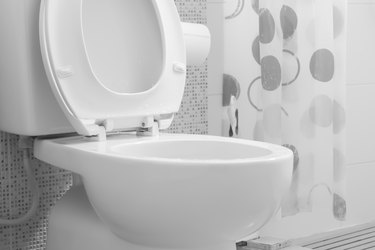
Maybe standing on the toilet seat caused it to crack or maybe the seat had been used just one time too many, but now that the damage has occurred, you risk a serious pinch to the derrière if you try to use the seat. Curtain & Bath Outlet recommends replacing it, because the crack is a portal for harmful bacteria. However, that risk isn't always that great, especially if the crack just happened. You can fix it, but the fix will be temporary. At some point, you'll have to bite the bullet and get a new toilet seat.
Tape a Cracked Toilet Seat
Video of the Day
They say duct tape fixes everything, but it isn't the best choice of tapes for a broken toilet seat. Its flexibility, which is a boon in most other circumstances, prevents it from providing much support. As the seat bends when you sit on it, the crack will still feel noticeable.
Video of the Day
There are better choices for repair tape for a toilet seat, and one of them is polyurethane tape. It's clear, which is one advantage over gray or black duct tape, and it has more sticking power and more body, so it offers more support.
The process for taping a toilet seat, as demonstrated on YouTube, is simple, but there's a right way and a wrong way. The right way is to push the crack closed as tightly as you can before wrapping the tape. If you don't do this and leave a gap, the tape is less likely to do its job, and it may tear.
Gluing It Might Work
If you're the do-it-yourself home-repair type, you probably have a tube of two-part epoxy in your tool closet. It makes sense to give this a try, but by itself, it won't make a very reliable repair on particleboard toilet seats, which is a common type of toilet seat. The chances of success are much better if your toilet seat is made of solid wood or thick plastic.
To make a solid repair, you need to clamp the crack closed while the glue sets, but the shape of the toilet seat can make this challenging. Remove the seat from the toilet, mix the epoxy and spread it in the crack, then position a bar clamp on the middle of the seat with its stops pressing against the rear and the midpoint of the oval-shaped front. Tighten the clamp and let the epoxy cure overnight for good measure before using the seat.
Add Shims for Stability
The chances are high that your particleboard toilet seat will crack again if you just glue it, so to prevent that, glue a strip of 1/8-inch plywood to the underside of the seat below the crack, after you've glued the crack together. If the seat has no bumpers, it's a good idea to glue an identical piece of plywood to the opposite side of the seat directly across from the crack to prevent the seat from wobbling while you use it.
Most seats have bumpers, and you should be able to either unscrew them before gluing on the shims or pry them off with a screwdriver if they're glued. Screw them back through the shims or glue them to the shims after completing the repair. Remember, this is just a temporary fix, but it should keep the seat serviceable long enough for you to find a new one.